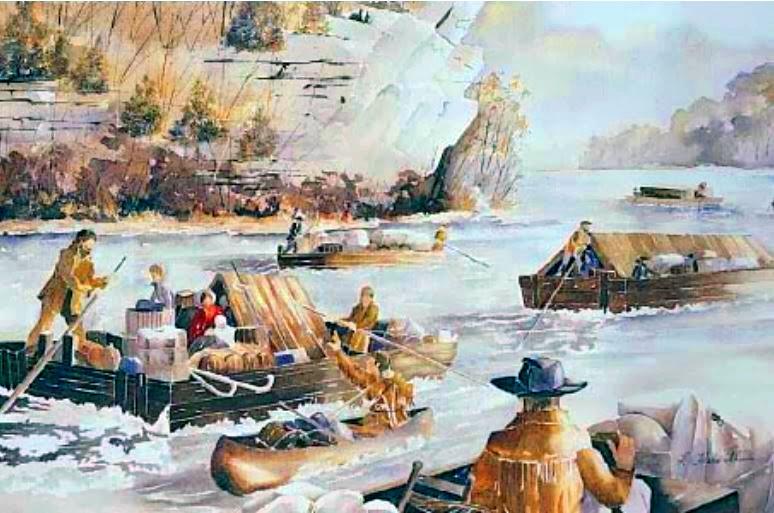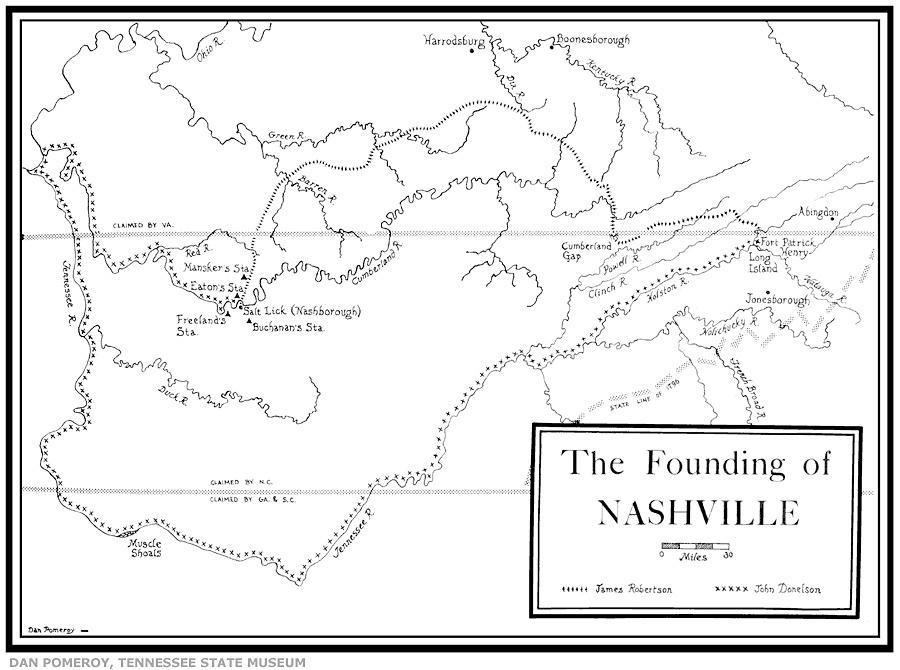
Timeline
Nashville Early 1800's
Nashville, originally called Nashborough, was established in 1779-80 on the west banks of the Cumberland River.

Illustration by Peggy Harville - Tennessee Blue Book
Two groups of pioneer settlers, led by the founding fathers James Robertson and Colonel John Donelson, came by land and by water from Fort Patrick Henry in east Tennessee. James Robertson led a party of men on foot and horseback, arriving on Christmas Day 1779. John Donelson led a flotilla of approximately thirty flatboats, carrying the wives and children of the men who went with Robertson. Traveling a thousand miles and surviving many hazards including Indian attacks, the Donelson party arrived on April 24, 1780, reuniting some 60 families.

Dan Pomeroy - Tennessee State Museum
For the first twenty years, settlers lived in small groups along the river and surrounding areas. They built forts or stations to protect themselves from Indian attacks. The transition from pioneer settlement to established town came with the defeat of the Indians, with increased traffic on the roads and river, and with statehood in 1796. By 1800, Nashville had a post office, a newspaper, stores and taverns, an inn, and a population that was achieving its goals of becoming merchants, lawyers, politicians, and landowners.
The arrival of the first steamboat in 1819 marked the end of frontier isolation and the beginning of a new age for Nashville. And for whom was this steamboat from New Orleans named? None other than Nashville's own General Jackson.
1767 – 1790
Childhood / Rachel's First Marriage
1791 – 1811
Rachel & Andrew / Early Life Together
1767
March 15: Andrew Jackson's born in the Waxhaws, South Carolina.
Date unknown: Rachel Donelson born, eighth child of John Donelson & Rachel Stockley.
Date unknown: Andrew Jackson, Sr., died; tradition says before Jackson was born.
1774
July 4: First Continental Congress convened in Philadelphia.
1779
c June 22: Hugh Jackson,Andrew's older brother, died.
December: Donelson family and party began river journey to western lands.
1780
April: Donelson party reached Fort Nashborough.
c Fall: Donelson family moved to Harrodsburg area in Kentucky.
1781
c May: Robert Jackson Andrew's middle brother, died Fall Elizabeth Jackson, Andrew's mother, died.
1785
c March: Rachel Donelson married Lewis Robards in Kentucky.
1786
Donelson family returned to Tennessee.
John Donelson murdered.
1784-1787
Jackson studied law under two different teachers.
1787
September 26: Jackson licensed to practice law in North Carolina.
1788
Date unknown:Rachel Robards returned to Nashville from Kentucky.
October: Jackson settled in Nashville.
November: Licensed to practice law in Davidson County.
1789
February 4: George Washington elected first president.
1790
December 20: Lewis Robards secured consent of Virginia legislature to seek divorce in Kentucky.
1791
c August : Rachel married Andrew Jackson for first time, in Natchez.
1792
February 23: Bought Poplar Grove farm in Davidson County; sold in October 1797.
1793
September 27: Lewis Robards' divorce from Rachel granted.
1794
January 18: Rachel married Andrew Jackson for second time.
1796
Jan 11—Feb 6: Jackson served in Tennessee Constitutional Convention.
June 1: Tennessee admitted as a state.
October 22: Jackson elected to U.S. House of Representatives.
December 5: Jackson took seat in Congress (in Philadelphia).
1797
September 26: Jackson elected to U.S. Senate from Tennessee.
November 22: Jackson took Senate seat (in Philadelphia).
1798
September 20: Jackson commissioned interim Tennessee Superior Court Judge.
December 20: Jackson elected Judge of Superior Court of Tennessee.
1799-1804
Jackson rode circuit as Judge of Superior Court
1801
c November 17 Rachel Stockley Donelson, Rachel Jackson's mother, died.
1802
February 5: Jackson elected Major General of Tennessee militia.
1804
March 26: Orleans Territory created; Jackson sought governorship.
July 23: Jackson resigned Superior Court judgeship.
August 23: Jackson purchased Hermitage property.
1804
March 26: Orleans Territory created; Jackson sought governorship.
July 23: Jackson resigned Superior Court judgeship.
August 23: Jackson purchased Hermitage property.
1805
May 11 Jackson purchased stud horse Truxton.
November 28 Race between Truxton and Ploughboy canceled.
1806
April 3 Race between Ploughboy and Truxton.
May 23 Jackson challenged Charles Dickinson to a duel.
May 30 Dickinson killed in duel; Jackson wounded.
1808
December 4: Andrew Jackson, son of Severn and Elizabeth Rucker Donelson, born; adopted by Jacksons.
1810
January: Jackson sought judgeship in Mississippi Territory.
1811
December 16: Severe earthquakes, centered about New Madrid, along the Mississippi Valley.
1812 – 1823
Military Victories/ Rise to Power
1824 – 1845
Presidential Years / Death
1812
February 6: U.S. declared war on Great Britain.
December 10: Second Division troops (of Tennessee militia) mustered in Nashville for expedition to New Orleans.
1813
January 1: Troops departed Nashville under Jackson.
February 6: Secretary of War ordered Jackson's troops dismissed.
March 24: Jackson's volunteers began return march to Nashville.
September 4: Jackson wounded in fight with Jesse and Thomas Hart Benton in Nashville.
September 24 : Second Division troops mustered in Nashville for departure to the Creek country; campaign against Creeks continued into 1814.
November 3: Lyncoya found and later sent to the Hermitage.
1814
May 28: General JacksonJackson commissioned major general of the U.S. Army by President Madison.
August 9: Treaty of Fort Jackson sealed Creek capitulation.
November 7: Jackson seized Pensacola.
December: Jackson arrived in New Orleans and imposed martial law.
1815
January 8: Battle of New Orleans.
April 6: Left New Orleans for Nashville.
c October 13: Jackson and Rachel left for Washington, taking Andrew, Jr., with them.
1816
February 1: Returned to Nashville from Washington.
1817
c February 22: Ralph E.W. Earl painted his first portrait of Jackson.
Fall: John Hutchings died; his five-year-old son Andrew Jackson Hutchings was named Jackson's ward and came to live at the Hermitage.
1818
April-May Troops under Jackson invaded Spanish Florida; occupied Pensacola.
1819
January: Jackson traveled to Washington to defend his actions in the Seminole campaign.
February: Jackson toured Maryland, Pennsylvania, and New York.
Summer: Construction begun on new house at the Hermitage; finished in 1821.
1821
March 10: Jackson appointed governor of Florida Territory.
July 17: Florida received for the U.S. from Spanish authorities.
November 13: Jackson resigned as governor of Florida.
1822
July 30: Tennessee legislature nominated Jackson for president.
1823
October 1: Jackson elected to the U.S. Senate; left for Washington in November.
1824
March 4: Jackson nominated for president.
1825
February 9: House of Representatives elected John Quincy Adams president.
April: Jacksons returned to Tennessee.
May 5: The Marquis de Lafayette visited the Hermitage.
1826
December: Nashville Central Committee began collecting affidavits concerning marriage of Rachel and Jackson.
1827
June: Nashville Central Committee completed report on marriage.
1828
January 8: Attended New Orleans anniversary celebration in New Orleans.
June 1: Lyncoya died.
November: Jackson elected president.
December 22: Rachel died.
1829
January 19 Jackson departed for Washington.
1832
November 1: Rachel Jackson, granddaughter, born.
March 4: Inauguration.
1833
March 4: Jackson inaugurated for 2nd term as president.
1834
April 4: Andrew Jackson III, grandson, born.
October 13: Hermitage partly destroyed by fire.
1845
June 8: Jackson died at the Hermitage, aged 78.
June 10: Rachel's TombJackson buried in the Hermitage garden beside Rachel.